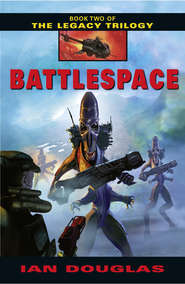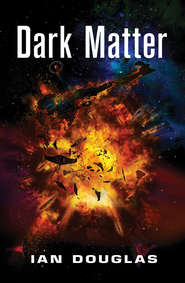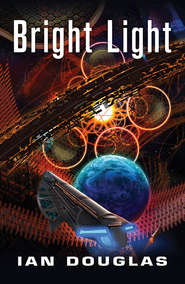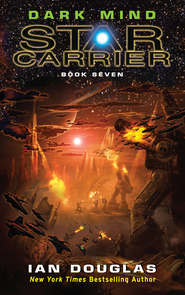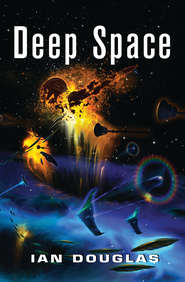По всем вопросам обращайтесь на: info@litportal.ru
(©) 2003-2024.
✖
Singularity
Настройки чтения
Размер шрифта
Высота строк
Поля
112 light years from Earth
1106 hours, TFT
“PriFly, this is Dragon One,” Gray called. “What’s the hang-up?” They were supposed to have dropped two minutes before, but Primary Flight Control had called for a hold.
“Wait one, Dragon One,” a voice replied—one of the traffic control personnel in PriFly. “There’s been a hitch. The Space Boss is talking to the admiral now.”
The “Space Boss” was Commander Avery, America’s primary flight controller.
Gray scowled. His cockpit was projecting a view of surrounding space, overlaid with icons representing the ships of CBG-18 as they continued to emerge from metaspace. A dozen Confederation vessels were out there, now, with more popping in every moment as the light from their Emergence reached the America’s sensors.
There were no icons representing enemy or unknown vessels. It appeared that this system might be clean.
Possibly the drop was going to be scrubbed.
Well, that was the battle cry of the Navy: hurry up and wait.
“Dragonfire Squadron, this is PriFly,” Commander Avery said. “The drop is scrubbed. Repeat, the drop is scrubbed. VFA-51 will remain on Ready Five. All others will stand down.”
VFA-51, the Black Lightnings, was one of the Dragonfires’ sister Starhawk squadrons on board the America. Commander Alton Crane was their new skipper, and like the Dragonfires, they’d taken heavy losses at Alphekka, and a good half of the pilots were newbies.
Gray felt a jolt as his Starhawk began rising within its magnetic cradle. A moment later, it passed through the drop-tube vacuum seal, allotropic composites within a nanomatrix that made solid metal flow like a thick, viscous liquid, allowing the fighter to be drawn into the carrier’s flight deck while maintaining the compartment’s atmospheric pressure. His cockpit melted open and swung away as a rating outside triggered steps that grew out of the deck.
“Short flight, huh?” the guy said, grinning.
“The best kind,” Gray replied with considerable feeling. “Uneventful.”
An hour later, Gray entered the crew’s lounge, located at the third-G level of America’s number-two hab-module stack. The compartment was large and furnished more like a civilian social center Earthside, with numerous entertainment pits, food bars, and low couches grown from the deck and turned soft. The overhead was an enormous dome, and at the moment, it was displaying the view outside. The local star, yellow, bright, and showing a tiny disk, gleamed halfway up the gently curving bulkhead.
Shay Ryan spotted him and walked over. “Hey, Skipper,” she called. “Looks like they don’t want us here, either.”
Like Gray, Ryan was a Prim, formerly of the Periphery areas that once had been Washington, D.C., until rising sea levels had reclaimed the lowland areas as a ruin-littered salt marsh. Like Gray, she’d joined the service because she’d had few decent options. Like him, she mistrusted both government authority and technology, but she’d tested well on her inborn spatial and coordination skills, and they’d made her a fighter pilot.
“Hello, Shay,” he said. He walked over to a food bar and placed his palm on the contact. He ordered a cola, which rose from within the black surface a moment later in a sealed cup with a built-in straw. “Looks like we lucked out, huh?”
“Shit. I don’t like going through all of that, getting ready to drop into hard-V, and then suddenly get pulled back. They’re just jerking us around, y’know?”
“Any day they pull us back,” Gray replied, “is a day we don’t get into a knife fight with toads.” Toads was pilot slang for the blunt, heavy, hard-to-kill fighters used by the Turusch. “And that suits me just fine.”
“I guess. Hey … did you see? A couple of our old friends are on deck.”
Gray turned and glanced in the direction she was pointing, his eyes widening a bit. “So! They’re allowing the spiders out to play?”
“Maybe the brass trusts them now.”
Gray glanced at the Marine staff sergeant standing behind the two Agletsch. “More likely they figure they can’t do any harm here. Let’s go say hi.”
Gray and Ryan both had met the two Agletsch three months earlier, just before the battlegroup had departed from Earth’s SupraQuito synchorbital complex. They’d been at a restaurant called the Overlook, and an officious headwaiter had been trying to expel the two many-legged aliens for no other reason than, as far as Gray could tell, that they didn’t happen to be human. Gray, Ryan, and several other service personnel had lodged a protest by leaving en masse, taking the Agletsch with them to another restaurant, one without so narrow a definition of acceptable patrons.
And they’d gotten to know the two pretty well, Gray thought, as well as it was possible to know beings with both physiologies and psychologies utterly different from anything from Earth.
A small crowd had gathered around the two Agletsch, who were standing with a lieutenant commander in a full dress uniform. Gray thought he recognized the guy—someone on Admiral Koenig’s staff. When he pinged the man’s id, he got back a name and rank: LCDR N. Cleary.
He wasn’t sure which alien was which, but he had their names stored in his implant memory. “Hey, Dra’ethde,” he said. “What brings you down here?”
The Agletsch on the right twisted two of its eye stalks around for a look, identifying itself for Gray as the one he’d named. “Ah! You are the fighter pilot Trevor Gray, yes-no?”
“Yes. We met at SupraQuito, remember?”
“We do. We are delighted to see you again. And Shay Ryan as well! We remember you, too.”
“Stay clear of this, Lieutenant,” Cleary said. “We’re on duty.”
“Doing what?” Ryan asked. “Watching vids?”
A three-meter-high portion of the viewall dome directly in front of the small group had been turned into a display window, showing, it appeared, a portion of the local star.
“We’re looking at what scrubbed your drop, Lieutenant,” Cleary said. “And we would appreciate it if you would stand back and not crowd.”
Gray and Ryan did move back, but only one step. Gray was intensely curious. So far as he could see, they were studying one quarter of the system’s G2 star. Nothing remarkable there at all.
“We have heard of this sort of thing, Commander,” Gru’mulkisch said, apparently continuing an interrupted discussion with Cleary. “But only in whispers. The Sh’daar masters do not speak of them.”
“Is it Sh’daar?” Cleary asked. “Did they build it?”
“Perhaps,” Dra’ethde said. “But it would have been in the Schjaa Krah. You would say the ‘Old Time,’ or possibly the ‘First Time,’ yes-no? A time a very, very long time ago, perhaps before they were the Sh’daar.”
“What the hell are you talking about?” Gray asked, then added, “Sir.”
For a moment, he thought Cleary was going to tell him to get lost, but the staff officer just shrugged and shook his head. “Have a look.”
A small square outlined in black appeared just below the limb of the star, then expanded, magnifying the image sharply. The image now showed the uneven granulations of the star’s surface: twisting, linear patterns of lesser light against the greater. And there was something else. …
To Gray, it looked like a fuzzy shadow, but one made out of light—bright light, but still dimmer than the glare from the star behind it. The thing, whatever it was, had a definite shape—elongated, considerably longer than it was wide—but it was masked in a hazy, twisted blur that made it look fuzzy and indistinct.
It was moving across the face of the star, and as it moved, the granulations appeared to pucker and twist behind it.
“It’s bending light,” Gray said.
“It looks like a dustball,” Ryan added.
Dustballs were tiny clots of matter scooped up by the flickering, artificial singularity projected ahead of a fighter or larger vessel using its gravitic drive to move through normal space. Though the drive singularity switched on and off thousands of times per second, it dragged hydrogen atoms, dust and debris swept up from the space ahead just as it did the fighter falling along behind it. In space where the local density of hydrogen and flecks of dust was relatively high—within the inner reaches of a star system, for instance—the dust could collect faster than the microscopic singularity could swallow it, creating tiny, light-bending patches of fuzz the fighter pilots called dustballs.
“What we’re looking at,” Cleary explained, “has a mass of about one point nine times ten to the thirty-third grams … or about the same as Earth’s sun.”
“A black hole?” Gray said.
Take a star as large as Sol and crush it down until it’s just six kilometers wide. What you get is a gravitational singularity with the same mass and the same gravitational field as the original star … but in close, very close, the gravitational field becomes so strong that not even light can escape it—hence the name: black hole.







